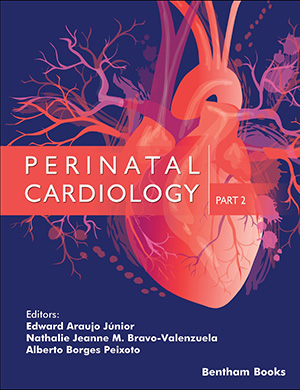Abstract
Fetal cardiac tumors (FCT) are rare anomalies (about 1% among prenatal cardiac problems). There are more frequent multiple FCT and less frequent single FCT. The FCT occur in the population of healthy young mothers and risk factors are not easily detectable, but environmental factors (benzapirin?) could play a role. Basic ultrasound (US) anatomy in the 1st and 2nd trimester usually is normal and FCT are usually detected in the second half of pregnancy. In the majority of cases the fetus’s growth is normal. In each case, targeted fetal echocardiography should be performed in a fetal cardiology center. The very first problem is to discriminate between normal heart anatomy and congenital heart defect. The second goal of fetal echocardiography in FCT is to make an assessment of the hemodynamic status of the fetus. Extracardiac and additional anomalies coexisting in cases of FTC can be divided into two types i.e., frequent and rare. An experienced fetal cardiologist can not only make a proper diagnosis but also should counsel parents about the short-term prognosis for the fetus (about his future during prenatal life) as well as long term prognosis (after birth and later on). In cases of maternal decision to continue the pregnancy, fetal echocardiography monitoring should be offered to evaluate possible hemodynamic changes, to prepare both fetus and pregnant woman for optimal time for delivery and perinatal care. The main goal would be to avoid prematurity and to confirm fetal wellbeing, despite the cardiac abnormality. Details of echocardiography and postnatal outcome are presented in rhabdomyoma, teratoma, fibroma, myxoma and hemangioma. The way of delivery in surgical resection of cardiac tumors in newborns is discussed. In differential diagnosis, “bright spot” is discussed. Suggested management – algorithm of perinatal care in cases of FCT is presented with emphasis on cooperation of a perinatal team. FCT can be diagnosed at 20 weeks of pregnancy, which allows to start echocardiographic monitoring, taking into consideration the potential risk of hemodynamic progression. FCT (both multiple and single) can be the first sign of tuberous sclerosis complex in later prenatal or postnatal life. Single FCT other than rhabdomyoma can be asymptomatic in newborns, but may require an early surgical resection, therefore delivery in tertiary centers is recommended. FCT are a good example of the practical value of prenatal cardiology development.
Keywords:
Differential diagnosis, Fibroma, Myxoma and Hemangioma, Perinatal management, Rhabdomyoma, Teratoma, Type of delivery.

